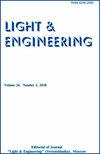极北地区建筑的可变热保护窗户
IF 0.3
4区 工程技术
Q4 ENGINEERING, ELECTRICAL & ELECTRONIC
引用次数: 0
摘要
首先,窗户是采光和视觉舒适的一个元素,但除此之外,窗户也可以是空调系统的一个元素。在自然通风的建筑中,外部空气通常通过窗户开口填充物中的泄漏或通过窗户元件-通风口,横梁进入。窗户也是建筑热保护的一个元素。在俄罗斯极北地区的气候条件下建造的建筑物中,它具有特殊的意义。该地区的特点是在冬季(极夜条件下)太阳时间非常短,甚至完全没有太阳时间。在这些条件下,窗户作为采光和视觉舒适元素的作用被关闭。增加窗户的热屏蔽特性的任务变得至关重要。在遥远的北方,通过适当的设计解决方案,窗户可以具有与墙壁相同的热保护。在温带气候条件下,可以在建筑物不使用的时期增加公共建筑窗户的热保护:在晚上,周末和节假日。本文概述了根据气候条件的变化、一天中的时间和人们的喜好改变窗户的光学特性和热屏蔽特性的新技术,并讨论了在远北条件下使用具有可变热保护的窗户提高建筑能源效率的可能性,以及“智能窗户”的新设计。本文章由计算机程序翻译,如有差异,请以英文原文为准。
Windows with Variable Thermal Protection for Buildings in the Far North
A window is, first, an element of daylighting and visual comfort, but, in addition, the window can be an element of an air-conditioning system. In a building with natural ventilation, the outside air inflow is conducted, as a rule, through leaks in the fillings of window openings or through window elements – vents, transoms. The window is also an element of the building’s thermal protection. It gets special significance in buildings built in the climatic conditions of the Russian Far North. This region is characterized by a very short duration or even complete absence of solar time in winter (in the polar night conditions). In these conditions, the role of the window as an element of daylighting and visual comfort is turned off. The task of increasing the heat-shielding characteristics of windows becomes essential. In the Far North, a window can have the same thermal protection as a wall with proper design solutions. In temperate climate conditions, it is possible to increase the thermal protection of windows in public buildings during the period when the building is not in use: at night, on weekends and holidays.
The paper provides an overview of new technologies for changing the optical properties and heat-shielding characteristics of windows, depending on changes in climatic conditions, time of day and people’s preferences, and discusses the possibilities of increasing the energy efficiency of buildings in the Far North conditions using windows with variable heat protection, as well as new designs of “smart windows”.
求助全文
通过发布文献求助,成功后即可免费获取论文全文。
去求助
来源期刊

Light & Engineering
ENGINEERING, ELECTRICAL & ELECTRONIC-OPTICS
CiteScore
1.00
自引率
50.00%
发文量
0
审稿时长
1 months
期刊介绍:
Our magazine
develops comprehensive communication within the lighting community, providing opportunities for discussion and free expression of opinions of specialists of different profiles;
contributes to the convergence of science and engineering practice, the search for opportunities for the application of research results in lighting and technological applications of light;
keeps the scientific community up to date with the latest advances in the theory of the light field, providing readers with operational professional information;
initiates international cooperation, promotes and distributes the results of Russian authors in the international professional community;
provides equal opportunities for authors from different regions of Russia and other countries.
The journal publishes articles in the following areas:
visual and non-visual effects of radiation on humans;
light field theory;
photometry and colorimetry;
sources of light;
ballasts;
light devices, their design and production technology;
lighting and irradiation installation;
light signaling;
methods of mathematical modeling of light devices and installations;
problems of energy saving in lighting, installation and operation of lighting installations;
modern production technologies of lighting products for lighting control systems;
innovative design solutions;
innovations in lighting and lighting design;
the study of the effect on plants and animals, problems of using light in medicine;
problems of disinfection of premises, water and smell elimination with the help of technology of UV radiation using;
problems of light in the ocean and space.
 求助内容:
求助内容: 应助结果提醒方式:
应助结果提醒方式:


